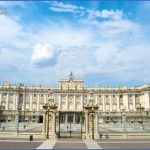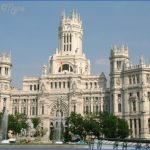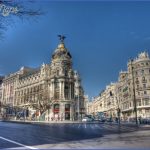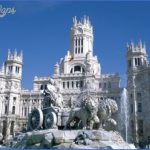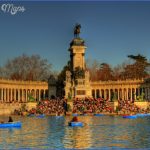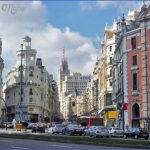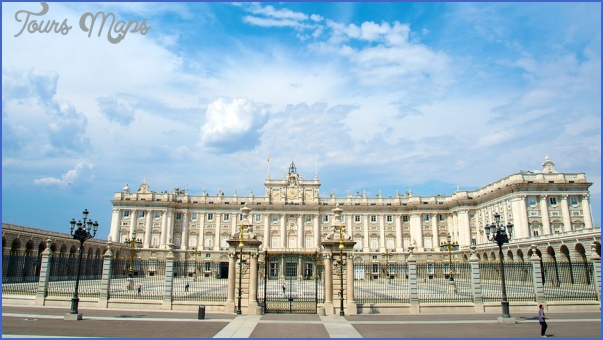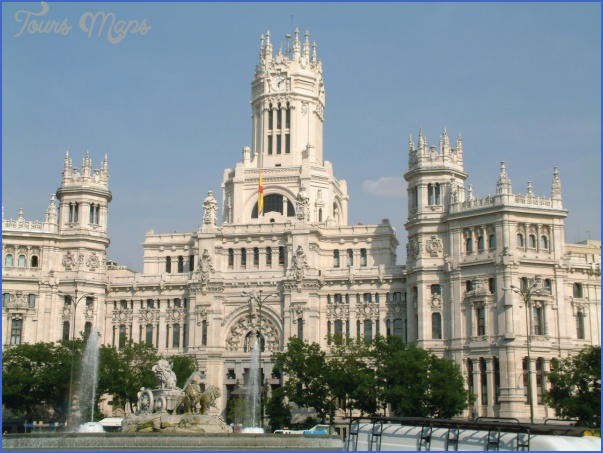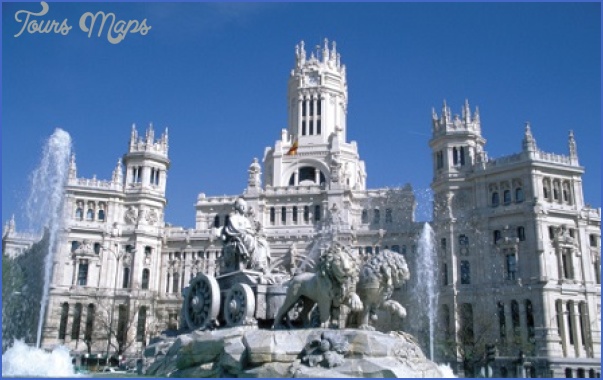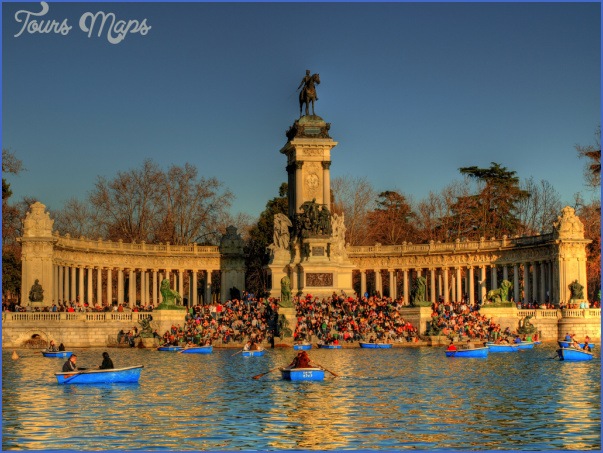Madrid Travel
RETIRO
Join an array of vendors, palm-readers, soccer players, and sunbathers in what Felipe IV converted from a hunting ground into a buen retiro (nice retreat). The finely landscaped 300-acre Parque del Buen Retiro is centered around a rectangular lake and a magnificent monument to King Alfonso XII. Dubbed Estanque Grande, this central location is popular among casual rowers. Built by Ricardo Velazquez to exhibit Filipino flowers, the exquisite steel-and-glass Palacio de Cris-tal hosts a variety of art shows. (Open Apr.-Sept. M and W-Sa llam-8pm, Su llam-6pm; Oct.-Mar. M and IV-Sa 10am-6pm, Su 10am-4pm. Free.) All artists should dream of having their art displayed in the Palacio de Velazquez, with its billowing ceilings, marble floors, and ideal lighting. (Past the Estanque, turn left on Paseo del Venezuela. Open Apr.-Sept. M and W-Sa llam-8pm, Su llam-6pm; Oct.-Mar. M and IV-Sa 10am-6pm, Su 10am-4pm. Closed Tu. Free.) Avoid venturing into the park alone after dark.
EL PARDO
Built as a hunting lodge for Carlos I in 1547, El Pardo was enlarged by generations of Habsburgs and Bourbons. El Pardo gained attention in 1940 when Franco made it his home, in which he resided until his death in 1975. It is renowned for its collection of tapestries several of which were designed by Goya but the palace also holds paintings by Velazquez and Ribera. (Take bus #601 (15min. ‚1) from the stop in front of the Efercito del Aire building. M: Moncloa. Palace open Apr.-Sept. M-Sa 10:30am-6pm, Su 9:20am-l:40pm; Oct.-Mar. M-Sa 10:30am-5pm, Su 9:50am-l:40pm. Required 45min. guided tour in Spanish. ‚3, students ‚1.50. IV EU citizens free.)
MUSEUMS
Madrid’s great museums need no introduction. If you’re not a student and plan on visiting the big three, your best bet is the Paseo del Arte ticket (‚7.66), which grants admission to the Museo del Prado, Museo Thyssen-Bomemisza, and Museo Centro de Arte Reina Sofia. The pass is available at all three museums.
MUSEO DEL PRADO
The Prado is Spam’s pride and joy, as well as one of Europe’s finest museums. Its 7000 pieces from the 12th-17th centuries are the result of hundreds of years of Bourbon art collecting. Each room is numbered and described in the museum’s free guide. On the second floor, keep an eye out for unforgiving realism and use of light in the works of Diego Velazquez (1599-1660), which resonate even in the 20th century. Several of his most famous paintings are here, including Los Borrachos (The Drunkards) and Las Lanzas (The Spears or The Surrender of Breda). Velazquez’s technique, called illu-sionism, climaxed in his magnum opus Las Meninas (The Maids of Honor).
The court portraitist Francisco de Goya y Lucientes (1746-1828) created the stark Dos de Mayo and Fusilamientas de Tres de Mayo, which depict the terrors of the Revolution of 1808. Goya painted the Pinturas Negras (Black Paintings) at the end of his life, deaf and alone. Satumo devorando a su hijo (Saturn Devouring His Son) stands out among the Pinturas Negras, a reminder from an ailing artist that time eventually destroys its creations. The Prado also displays many of El Greco’s religious paintings. La Trinidad (The Trinity) and La adoracidn de los pastores (The Adoration of the Shepherds) are characterized by luminous colors, elongated figures, and mystical subjects. On the second floor are other works by Spanish artists, including Murillo, Ribera, and Zurbaran.
The Prado also has a collection of Italian works, including pieces by Titian, Raphael, Tintoretto, Botticelli, and Rubens. As a result of the Spanish Habsburgs’ control of the Netherlands, the Flemish holdings are also top-notch. Works by van Dyck and Albrecht Durer are here, including Peter Breugel the Elder’s The Triumph of Death, in which death drives a carriage of skulls on a decaying horse. Hieronymus Bosch’s moralistic The Garden of Earthly Delights depicts hedonism and the destiny that awaits its practitioners. (Po. del Prado at PI. Ctinovas del Castillo. M: Banco de Espana or Atocha. sfax 913 30 28 00; http:museoprado.mcu.es. Open Su and Tu-Sa 9am-7pm. ‚3, students ‚1.50. Under-18, over-65, and Su free.)
MUSEO THYSSEN-BORNEMISZA
Unlike the Prado and the Reina Sofia, the Thyssen-Bomemisza covers a wide range of periods and media, with exhibits ranging from 14th-century canvases to 20th-century sculptures. Baron Heinrich Thyssen-Bomemisza donated his collection in 1993, and today the museum, with over 775 pieces, is the world’s most extensive private showcase. To view the collection in chronological order and observe the evolution of styles and themes, begin on the top floor and work your way down the organization provokes natural comparisons across centuries. The top floor is dedicated to the Old Masters collection, which includes such notables as Hans Holbein’s austere Portrait of Henry VIII and El Greco’s Annunciation. In both variety and quality, the Thyssen-Bomemisza’s Baroque collection, including pieces by Caravaggio, Jose de Ribera, and Claude Lorraine, outshines that of the Prado. The Impressionist and Post-Impressionist collections explode with texture and color look for works by Cezanne, Degas, Manet, Matisse, Monet, Pisarro, Renoir, Toulouse-Lautrec, and van Gogh. The highlight of the museum is the 20th-century collection, on the first floor. The modem artists showcased include Chagall, Dalf, Ernst, Gorky, Hopper, Kandinsky, Klee, Leger, Miro, Mondrian, O’Keefe, Picasso, Pollack, and Rothko. (On the corner of Po. del Prado and C. San Jeronimo. M: Banco de Espana. Bus #6, 14, 27,37, or 45. &913 69 01 51; www.museothyssen.org. Open Su and Tu-Sa 10am-7pm. Last entrance 6:30pm. ‚4.80, students with ISIC and seniors ‚3. Under-12 free.)
MUSEO NACIONAL CENTRO DE ARTE REINA SOFIA
Since Juan Carlos I decreed this renovated hospital the national museum in 1988, the Reina Sofia’s collection of 20th-century art has grown steadily. Rooms dedicated to Juan Gris, Salvador Dali, and Joan Miro display Spain’s vital contributions to the Surrealist movement. Picasso’s masterwork Guernica is the centerpiece of
the Reina Sofia’s permanent collection. It depicts the Basque town (see 956) bombed by the Germans at Franco’s request during the Spanish Civil War. Picasso denounced the bloodshed in a huge, colorless work of contorted, agonized figures. When asked by Nazi officials whether he was responsible for this work, Picasso answered, No, you are. He gave the canvas to New York’s Museum of Modem Art on the condition that they return it to Spain when democracy was restored. The subsequent move to the Reina Sofia sparked an international controversy Picasso’s other stipulation had been that the painting hang only in the Prado, to affirm his equivalent status with artists like Titian and Velazquez. (C. Santa Isabel 52. M: Atocha. s914 67 50 62 or 68 30 02; http:museoreinasofia.mcu.es. Open M and IV-Sa 10am-9pm, Su 10am-2:30pm. ‚3, students ‚1.50. Sa after 2:30pm, Su, and holidays free.)
MUSEO DE AMERICA. This under-appreciated museum documents the cultures of America’s pre-Columbian civilizations and the legacy of the Spanish conquest. (M: Moncloa. Av. Reyes Catolicos 6, next to the Faro de Moncloa. Open Su and Tu-Sa 9:30am-3pm. ‚3, students ‚1.50. Under-18, over-65, and Su free.)
MUSEO DE LA REAL ACADEMIA DE BELLAS ARTES DE SAN FERNANDO. An
excellent collection of the Old Masters, surpassed only by the Prado. (M: Sol. C. Alcala 13. Open Tu-F 9am-7pm, Sa-M 9am-2:30pm. ‚2.50, students ‚1.25. IV free.)
RASTRO (FLEA MARKET)
For hundreds of years, El Rastro has been a Sunday morning tradition in Madrid. The market begins in La Latina at PI. Cascorro off C. Toledo and ends at the bottom of C. Ribera de Curtidores. Get lost in the insanity and the excitement as your senses become overwhelmed with sights, sounds, and smells from every direction. Seek out that souvenir you’ve been dying for since your first day in Madrid and haggle for it until you’re blue in the face. In El Rastro you can find anything, from pots to jeans to antique tools to pet birds. As crazy as the market seems, it is actually thematically organized. The main street is a labyrinth of cheap jewelry, incense, and sunglasses, branching out into side streets, each with its own concert of vendors and wares. Antique-sellers contribute their peculiar mustiness to C. del Prado. Tapas bars and small restaurants line the streets and provide an air-conditioned respite for market-weary bargain-hunters. The flea market is a pickpocket’s paradise, so leave your camera in your room, bust out with the money belt, or turn that backpack into a frontpack. Police are everywhere if you have any problems. (El Rastro is open Sundays and holidays from 9am to 2pm.)
Madrid Travel Photo Gallery
Maybe You Like Them Too
- Explore Roslyakovo, Russia with this Interactive Map
- Explore Higueras de los Natoches, Mexico with this detailed map
- Explore Gudauta Georgia with this detailed map
- Explore Ghanaur, India with our Interactive Map
- Explore Houplines, France with this detailed map

